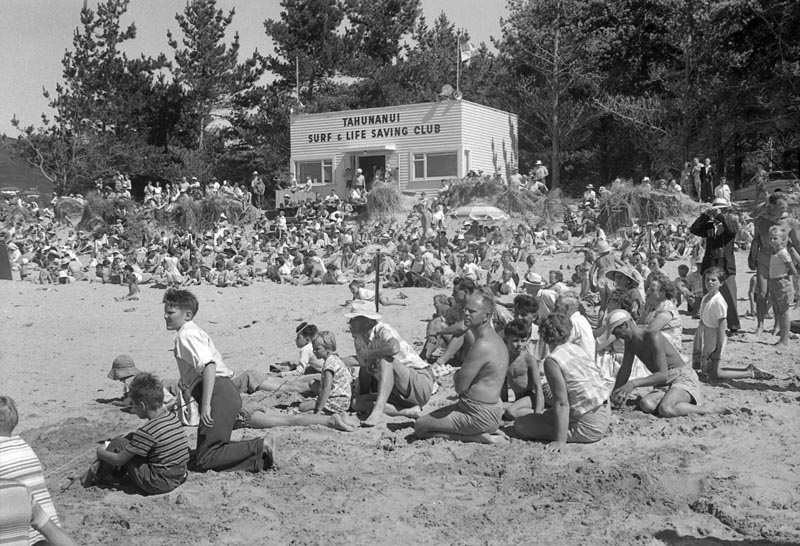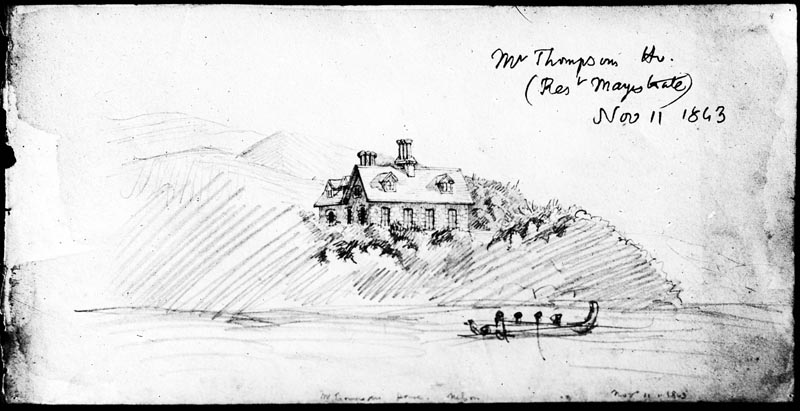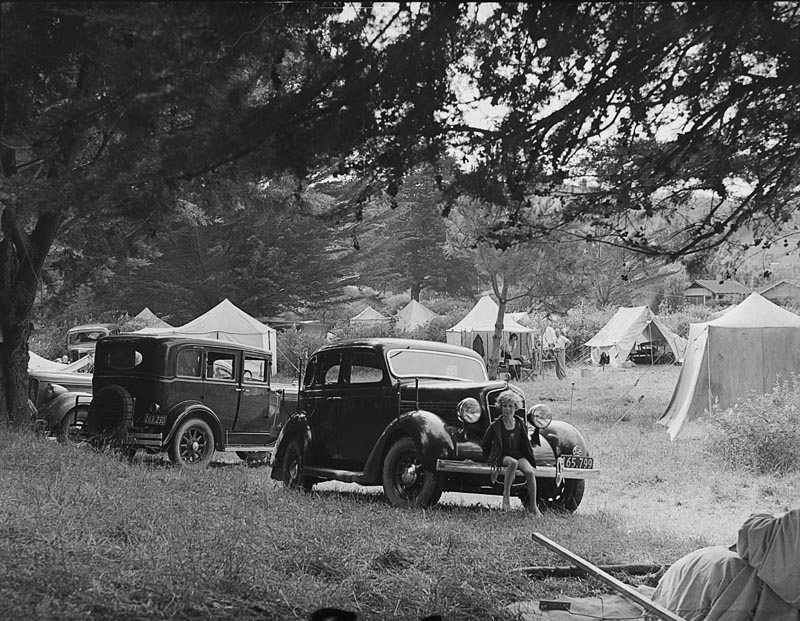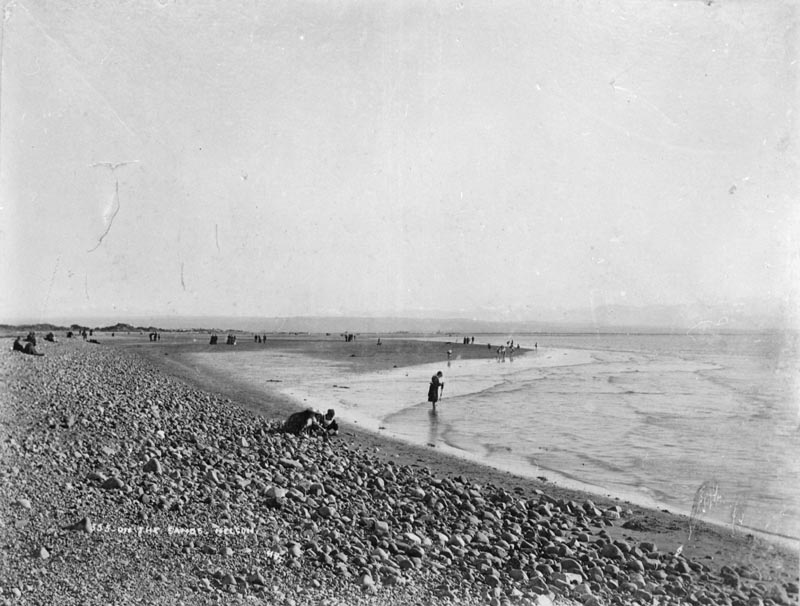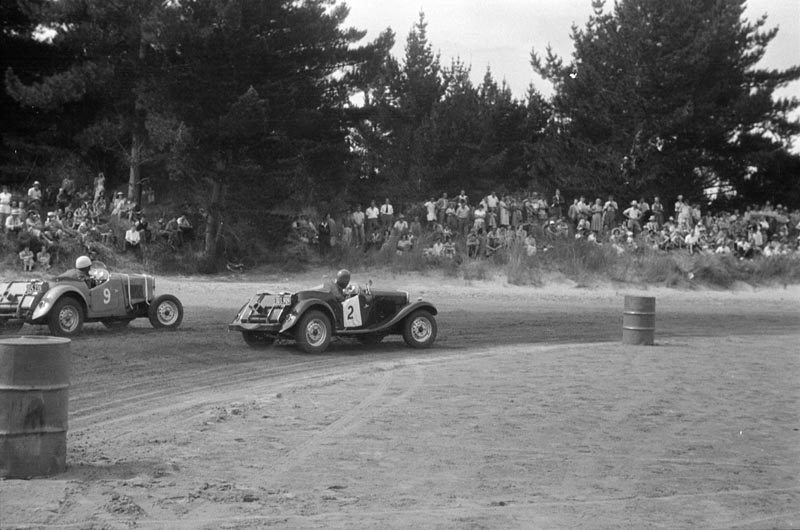Tāhunanui
Tāhunanui, an area of dynamic landscape, has had a history independent of the Town of Nelson. The name Tāhunanui Beach was commonly known as ‘The Sands' until a competition was run in 1902 to suggest a name, with a prize of One Guinea.
Tāhunanui, an area of dynamic landscape, has had a history independent of the Town of Nelson.
The name
Tāhunanui Beach was commonly known as ‘The Sands' until a competition was run in 1902 to suggest a name, with a prize of One Guinea. 442 suggestions were made and the Māori name Tāhuna was selected, meaning ‘sea beach' or ‘sand hill'. This caused a problem for the post office, however, as there was an existing Tāhuna Post Office in Morrinsville, so the name Tātahi (beach) was suggested, and was in use from 1908. Tatahi was not popular, however, so the name Tāhunanui was coined, referring to the locality, and was officially granted in 1911.
Māori history
Māori first settled around the Waimea Inlet over 600 years ago. Successive tribes made their camps and settlements on the coast and islands where the channels gave water access, even at low tide. One of the oldest of these camps was located near the junction of Bisley Avenue and Rocks Road (then at the edge of the Waimea Inlet). Nestled in sand dunes this camp allowed people to harvest kaimoana from both the inlet and the open waters of Tāsman Bay / Te Tai-o-Aorere. Archaeological evidence from this site includes fish hooks (including some of moa bone), stone drill points of argillite (sourced from the Nelson Mineral Belt and used to make fish hooks), and a large number of argillite flakes left behind by adze makers. Bones from the midden show that snapper, kahawai and barracouta were the most common fish species caught and other food included moa, weka, NZ pigeon kererū, spotted shag, Polynesian dog and Southern fur seal. Dates from charcoal show that people were living here around 1400 AD.1
European settlement
When Europeans arrived in Whakatū Nelson, the main channel draining the Waimea Inlet crossed the present-day beach. Sailing ships (up to 500 tons) used the channel to access Parkers Cove (the Black Stump), where livestock was unloaded for nearby quarantine yards (Quarantine Road). The river mouth was used as an alternative port for Nelson. What is now Tāhunanui was then outside Arthur Wakefield's Town of Nelson, and part of Suburban south. The land sections in this area sold slowly.
The first European house at Tāhunanui, Penton, was sited on the hill above Rocks Road. It was used as a sailing mark for vessels entering the Waimea River. Owner Henry Thompson, Nelson's Resident Magistrate, started building in 1842. His death at the Wairau the following year abruptly ended progress and the neglected house was demolished around 1856. The next resident was Jonas Rider, a flax dresser, who established a flax mill in the area. Another early, and short-lived, industry was lime preparation from the quarries in Poorman's Valley.
In 1867 Edward Green, tailor turned farmer, extended his Bolt Road holding to include the triangle between Tāhunanui Drive, Parkers Road and Beach Roads, where the aerodrome and golf course are now sited. His first wooden home burned down but his second became a Tāhunanui landmark, sited about the end of what is now Roto Street. Green was a farmer, and caused some disquiet in the neighbourhood by blocking the road past his farm to keep his stock secure.
A playground not a port
In the 1870s The Waimea Bank breached, forming a new channel, and by 1882 the old channel was dry at low tide. Tāhunanui's days as a port were over. However, ten years later, new transport options were opening for Tāhunanui, when, in 1892, the sea wall and Rocks Road were started, opening in 1899. Prior to this, the carriageway to Tāhunanui was via Annesbrook, but many people had used the route around the rocks at low tide, on foot and horseback.
In the same year, 1899, the executors of the Green Estate agreed to sell the Tāhunanui sand flats to the city council. A 1910 Declaration of Trust stated the land was for the "health, amusement and instruction of the inhabitants of the City of Nelson ...". The Tahuna Progressive Association was formed to improve the beach by erecting changing sheds, shelter sheds and planting trees.
Nelson City Council held ownership of the land, after considerable dispute with the Nelson Harbour Board who declared it part of their foreshore endowment. In 1926, the Tahuna Sands Association was formed to look after the Reserve, at which stage Nelson City Council was prompted to provide significant funds for improvements. It did not proceed, however, with the Association's grand scheme, which included boulevards and a two-storey restaurant. Bisley and Moana Avenues were completed in 1929, opening up much of the hillside for housing.
In the 1930s the Tahuna Sands Association made considerable ‘improvements' to the beach area, including Hounsell Circle and associated facilities. The Association established the Motor Camp and more than 1000 campers stayed there in 1938. Since 1961 the camp has been managed by The Tāhuna Beach Camp Incorporated.
An area that had been levelled for a wartime anti-aircraft gun battery (current skating rink) was leased for a dine and dance building in the 1940's. The annual back beach motor races (with the addition of motorcycle races in later years), also became a highlight of the Nelson calendar from 1949 until 1977. In the 1950s the roller skating rink was constructed (1954), Rocks Road was upgraded and the sea wall resurfaced to break the waves, and a surf club was formed. A summer highlight was the annual beach carnival.
The Council had direct control of the Reserve after terminating the lease to the Tahuna Sands Association in 1961. A number of developments were undertaken, despite extremely serious beach erosion. This has continued to be a problem, and in 2005 a community-assisted coast care project was started and the stormwater drain by the Abel Tasman park was realigned.
Tāhunanui continues to be a vibrant community, which expands in size each summer, welcoming the many tourists who enjoy the, now more stable, beach and associated facilities.
Tāhuanui Landmarks
- Abel Tasman Park - first formed in 1958 from spoil stored on the dunes during Rocks Road upgrading. Abel Tasman’s statue was installed in 2002.
- Nightingale Library - built in 1961 with a bequest from Nellie Nightingale, resident of Tāhunanui.
- Bisley Walk - formed in 1959 along an existing walking track.
- Lions playground - first established in 1963. It has suffered severe erosion in the past.
- Tennis courts - constructed in the 1930s around the same time as the shelter, which dates from 1930’s
- Hounsell Circle - built with a bequest from Jesse Hounsell.
- Fun park - mini golf opened in 1966, bumper boats in 1983, hydro-slide and Indy 500 track 1986.
- Skating rink - built in 1954, a club was formed on November 4 1954 and the rink roofed in 1982.
- Natureland Zoo - opened in 1966.
- Modellers pond - first built in the 1930s and restored in 1959. A model railway started in 1961 with upgrades to facilities in 1963, 1980 and 2004. The pond, which once featured model boats, has been much debated over the years, plagued by algae and pollution it was often closed. A decision to fill it in was made in 2020 and in 2022 a park was created on the site and named Te Pā Harakeke. The much loved railway continues to run, operated by the Nelson Society of Modellers.
- BMX track - laid out in 1981.
- Back beach - once an old racing circuit, the Back Beach is now protected to encourage the re-establishment of its estuarine ecology.
- Blind Channel - certainly not blind today, the channel could have been named around the 1880s when the Waimea Bank was breached, leaving the old channel to become increasingly difficult to navigate (blind) until it dried up. The breached channel, steadily moving eastwards, then took on the old channel’s name. The Channel is now moving steadily eastwards, extending the spit to the north.
- Burrell Park - Emily Burrell gave land to the Town Board in 1938.
- Paddy's Knob - According to the Plaque at the site, it was named after Patrick Maurice (Paddy) Day, 1854-1947: " At the tender age of two and a half years young Paddy wandered away from his mother and became lost. The family lived in a tent house at The Baskin on Rocks Road, as did other pioneer families. After a search of two days the toddler was found curled up and fast asleep on what was then a bush covered hill."
The information in this story was written for the Nelson City Council Heritage plaques at Tāhunanui Beach, 2008 (updated 2022)
Story by: Janet Bathgate
Sources
- Millar, D. (June, 1967) The Archaic site at Tahunanui. In, Recent Archaeological Excavations in the Northern Part of the South Island, Nelson Historical Society Journal, 2, p.9
http://nzetc.victoria.ac.nz/tm/scholarly/tei-NHSJ02_02-t1-body1-d2-d5.html
Further Sources
Books
- Dickinson, B.E. (1989) Historic Tahuna [Nelson, N.Z.] : B. Dickinson
http://www.worldcat.org/oclc/154423496 - Draft management plan for Tahuna Sands (1989) Nelson: Nelson City Council [held Nelson Public Libraries]
- Stade, K. (2008) The school by the sands: a century of Tahunanui School, Nelson, 1908-2008. [Nelson, N.Z.] : Tahunanui School
http://www.worldcat.org/oclc/250525973 - Stephens, M. (1996) The Tahunanui Beach motor racing years of the Nelson Car Club, 1949-1977. [Nelson, N.Z.] : Sandhills (Mapua)
http://www.worldcat.org/oclc/154648960 - Tahunanui Beach erosion study (2000) Ocel Consultants Ltd [held Nelson Public Libraries]
- Warren, K. (2009) Rolling Stones. Nelson, N.Z.: Nikau Press
http://www.worldcat.org/oclc/506383372
Newspapers
- Millar, D. (1967) . The Archaic Site at Tahunanui. In Recent archaeological excavations in the Northern Part of the South Island. Nelson Historical Society Journal, 2(2), p.9
http://www.nzetc.org/tm/scholarly/tei-NHSJ02_02-t1-body1-d2-d5.html - Pascoe Street: origins as a farm track (1992, October) Haven, 33, p.13
Websites
- Greater Nelson. (1925, November 24) Evening Post, p. 9
http://paperspast.natlib.govt.nz/cgi-bin/paperspast?a=d&cl=search&d=EP19251124.2.91 - Tahunanui (1909, October 21) Nelson Evening Mail, p.2
http://paperspast.natlib.govt.nz/cgi-bin/paperspast?a=d&cl=search&d=NEM19091021.2.15 - Flax (1844, June 15) Nelson Examiner and New Zealand Chronicle, p.58
http://paperspast.natlib.govt.nz/cgi-bin/paperspast?a=d&cl=search&d=NENZC18440615.2. - Sands of time (2013, January 5). Retrieved from History Geek:
https://historygeek.co.nz/2013/01/05/sands-of-time-tahunanui-beach/
